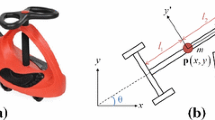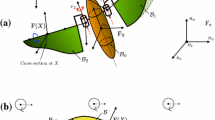Abstract
One of the performance indices for either a biological or a biomimetic locomotion system is the degree of its maneuverability i.e. the most rigid body velocity changing due to finite shape variable rates. The main subject of this article is to compute general rules for this index using geometric tools. Specifically, the fiber bundle structure is employed to extract the shape dynamics from the whole system and investigate the effects of them over the rigid body motion. First, an analogy between the manipulability Jacobian for robotic arms and geometric connection of kinematically reducible robotic locomotion system is made. The analogy leads one to obtain and compute the local maneuverability ellipses for such robots. The ellipses give some general but quantitative measures of maneuverability that can be used in the design of such systems. A three links fish-like robot as a candidate of a locomotion system with symmetry and a three links kinematic snake robot as a candidate of principally kinematic locomotion are selected and their maneuvering responses are investigated. The best body configuration for the most and least translational, arched and rotation maneuvers are obtained for prescribedrobots. Some other valuable information such as bifurcation occurrence in response is accomplished using maneuverability ellipses. Finally, the results are validated by two methods; first by direct numerical solving of governing equation and second by comparing to other works in literature.
Similar content being viewed by others
References
Fish, F.E.: Performance constraints on the maneuverability of flexible and rigid biological systems. In: Proceedings of the eleventh international symposium on unmanned untethered submersible technology, pp 394–406 (1999)
Bandyopadhyay, P.R.: Maneuvering hydrodynamics of fish and small underwater vehicles. Integ. Comp. Biol. 42, 102–117 (2002)
Fish, F.E.: Balancing requirements for stability and maneuverability in cetaceans. Integ. Comp. Biol. 42, 88–93 (2002)
Fish, F.E.: Comparative kinematics and hydrodynamics of odontocete cetaceans: morphological and ecological correlates with swimming performance. J. Exp. Biol. 201, 2867–2877 (1998)
Fish, F.E., Hurley, J., Costa, D.P.: Maneuverability by the Sea Lion Zalophus Californianus: turning performance of an unstable body design. J. Exp. Biol. 206, 667–674 (2003)
Fish, F.E., Nicastro, A.J.: Aquatic turning performance by the whirligig beetle: constraints on maneuverability by a rigid biological system. J. Exp. Biol. 206, 1649–1656 (2003)
Maresh, J., Fish, F.E., Nowacek, D.P., Nowacek, S.M., Wells, S.: High performance turning capabilities during foraging by bottlenose dolphins. Marine Mammal Science 20(3), 498–509 (2004)
Hatton, R.L., Burton, L.J., Hosoi, A.E., Choset, H.: Geometric maneuverability with applications to low reynolds number swimming. In: 2011 IEEE/RSJ international conference on intelligent robots and systems (IROS), pp 3893–3898. IEEE (2011)
Gosselin, C.M.: The optimum design of robotic manipulators using dexterity indices. Robot. Auton. Syst. 9(4), 213–226 (1992)
Pond, G., Carretero, J.A.: Formulating Jacobian matrices for the dexterity analysis of parallel manipulators. Mechanism and Machine Theory 41(12), 1505–1519 (2006)
Ferreira, N.M.F., Tenreiro Machado, J.A.: Manipulability analysis of two-arm robotic systems. In: Proceedings of IEEE international conference on intelligent engineering systems, vol. 1(1), pp 101–109 (2000)
Jun, B.-H., Lee, P.-M., Lee, J.: Manipulability analysis of underwater robotic arms on ROV and application to task-oriented joint configuration. In: IEEE OCEANS’04. MTTS/IEEE TECHNO-OCEAN’04, vol. 3, pp 1548–1553 (2004)
Merlet, J.-P.: Jacobian, manipulability, condition number, and accuracy of parallel robots. J. Mech. Des. 128(1), 199–206 (2006)
Ostrowski, J.P.: The mechanics and control of undulatory robotic locomotion. PhD diss., California Institute of Technology (1996)
Bloch, A.M., Krishnaprasad, P.S., Marsden, J.E., Murray, R.M.: Nonholonomic mechanical systems with symmetry. Arch. Ration. Mech. Anal. 136(1), 21–99 (1996)
Radford, J.E., Burdick, J.W.: Local Motion Planning for Nonholonomic Control Systems Evolving on Principal Bundles. Proc. Mathematical Theory of Networks and Systems (1998)
Shammas, E.: Generalized Motion Planning for Underactuated Mechanical systems. Ph.D. thesis, Carnegie Mellon University, Pittsburgh (2006)
Engardt, M., Heimburger, A., Sydhoff, P.: Manipulability index optimization for a planar robotic arm. Thesis in Engineering Physics, KTH, Royal Institute of Technology, Stockholm (2012)
Kanso, E., Marsden, J.E., Rowley, C.W., Melli-Hubber, J.B.: Locomotion of articulated bodies in a perfect fluid. J. Nonlinear Sci. 15, 255–289 (2005)
Melli, J.B., Rowley, C.W., Rufat, D.S.: Motion planning for an articulated body in a perfect planar fluid. SIAM J. Appl. Dyn. Syst. 5(4), 650–669 (2006)
Asnafi, A., Mahzoon, M.: The role of connection in the nonlinear behavior of locomotion systems with symmetry. Multibody Syst. Dyn. 24(2), 167–180 (2010)
Asnafi, A., Mahzoon, M.: On designing geometric motion planners to solve regulating and trajectory tracking problems for robotic locomotion systems. Bioinspiration Biomimetics 6(3), 036005 (2011)
Tam, D., Hosoi, A.E.: Optimal stroke patterns for Purcell’s three-link swimmer. Phys. Rev. Lett. 98(6), 068105 (2007)
Ostrowski, J.P.: The mechanics and control of undulatory robotic locomotion. Ph.D. thesis, California Institute of Technology, California (1995)
Asnafi, A: Geometric control of robotic locomotion systems. Ph.D. thesis, Shiraz University, Shiraz (2007)
Author information
Authors and Affiliations
Corresponding author
Rights and permissions
About this article
Cite this article
Asnafi, A. A Method to Investigate General Optimal Maneuvers for Kinematically Reducible Robotic Locomotion Systems. J Intell Robot Syst 84, 799–813 (2016). https://doi.org/10.1007/s10846-016-0369-5
Received:
Accepted:
Published:
Issue Date:
DOI: https://doi.org/10.1007/s10846-016-0369-5




